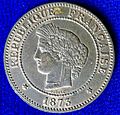Ceres facts for kids
Quick facts for kids Ceres |
|
|---|---|
| Goddess of agriculture, fertility, grains, the harvest, motherhood, the earth, and cultivated crops | |

Seated Ceres from Emerita Augusta, present-day Mérida, Spain (National Museum of Roman Art, 1st century AD)
|
|
| Planet | 1 Ceres |
| Symbol | sickle, sheaf of wheat, cornucopia, cereal |
| Personal information | |
| Children | Proserpina |
| Parents | Saturn and Ops |
| Siblings | Jupiter, Juno, Neptune, Vesta, Pluto |
| Equivalents | |
| Greek equivalent | Demeter |
| Japanese equivalent | Amaterasu |
In Roman mythology, Ceres was a very important goddess. She was known as the goddess of agriculture, which means she looked after farming and crops. This included growing grains and cereals.
Ceres also represented good fertility, meaning the ability of land to grow plants. She was also linked to motherhood and caring relationships. Her parents were Saturn and Ops. She was the mother of Proserpina.
Contents
Who Was Ceres?
Ceres was one of the oldest Roman gods. She was part of a group called the Dii Consentes, which were the twelve most important gods. Romans believed she helped their crops grow well. She made sure there was enough food for everyone.
Her name, Ceres, is where we get the word "cereal" from today. This shows how important she was for grains. People often pictured her holding a sickle or a sheaf of wheat. These are tools and plants related to farming.
Ceres's Family and Story
Ceres was the daughter of Saturn, the god of time and agriculture. Her mother was Ops, the goddess of fertility and the earth. She had several famous siblings, including Jupiter, the king of the gods, and Juno, the queen of the gods.
Ceres's most famous story involves her daughter, Proserpina. Proserpina was taken to the underworld by Pluto, the god of the underworld. Ceres was very sad and searched everywhere for her. Her sadness caused the earth to become barren. No crops would grow.
Eventually, Jupiter helped arrange for Proserpina to return to her mother for part of the year. When Proserpina is with Ceres, the earth is fertile and crops grow (spring and summer). When Proserpina returns to Pluto, Ceres grieves, and the earth becomes cold and barren (autumn and winter). This story explains the changing seasons.
Ceres in Modern Times
Even today, Ceres is remembered in different ways. A large statue of Ceres stands on top of the Chicago Board of Trade Building in Chicago, Illinois, United States. This building is important for trading grains. The statue shows her lasting connection to agriculture.
Also, the largest dwarf planet in our solar system is named 1 Ceres. It was discovered in 1801 and named after the goddess. This shows her importance even in astronomy.
Related Pages
- Demeter - The Greek mythology version of Ceres.
Images for kids
-
Funerary statue of an unknown woman, depicted as Ceres holding wheat. Mid 3rd century AD. (Louvre)
-
A Greek fresco depicting the goddess Demeter, from Panticapaeum in the ancient Bosporan Kingdom (a client state of the Roman Empire), 1st century AD, Crimea.
-
A 3-storey faceless depiction of Ceres rests atop the Chicago Board of Trade Building.
-
Emperors celebrated imperial and divine partnerships in grain import and provision. On this sestertius of 66 AD, Nero's garlanded head is left. Opposite, a standing Annona holds cornucopiae (horns of Plenty) and enthroned Ceres holds grain-ears and torch. Between them on a garlanded altar, a modius (grain measure), and in the background, a ship's stern.
-
Ceres by Eugène-André Oudiné on a French coin of 1873 (3rd Republic).
-
Official seal of New Jersey. Ceres is the figure on the right. She symbolizes the "Prosperity" aspect of the state Motto.
See also
 In Spanish: Ceres para niños
In Spanish: Ceres para niños









